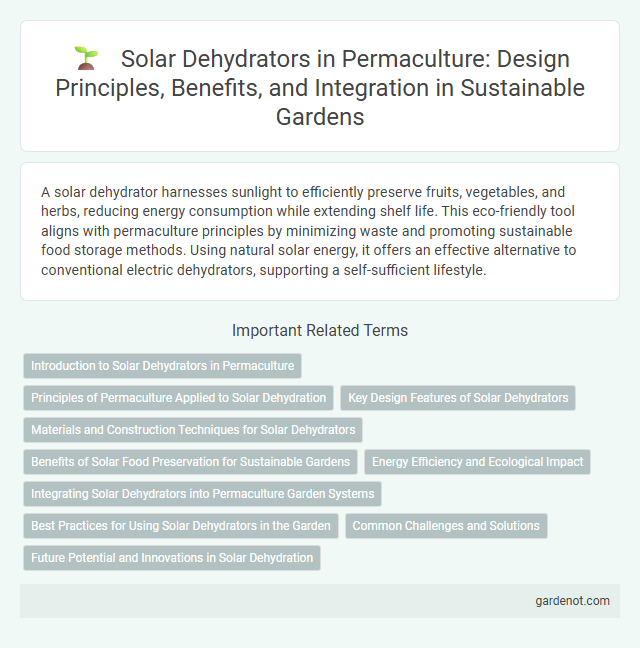A solar dehydrator harnesses sunlight to efficiently preserve fruits, vegetables, and herbs, reducing energy consumption while extending shelf life. This eco-friendly tool aligns with permaculture principles by minimizing waste and promoting sustainable food storage methods. Using natural solar energy, it offers an effective alternative to conventional electric dehydrators, supporting a self-sufficient lifestyle.
Introduction to Solar Dehydrators in Permaculture
Solar dehydrators are essential tools in permaculture for sustainably preserving fruits, vegetables, and herbs by harnessing solar energy to remove moisture efficiently. These devices optimize natural airflow and solar heat, extending the shelf life of produce while minimizing energy consumption and reducing food waste. Integrating solar dehydrators in permaculture systems enhances self-sufficiency, supports seasonal food storage, and aligns with eco-friendly, renewable resource principles.
Principles of Permaculture Applied to Solar Dehydration
Solar dehydrators embody permaculture principles by harnessing renewable solar energy to sustainably preserve food, reducing waste and energy consumption. The design maximizes passive solar gain and natural airflow, aligning with permaculture's emphasis on energy efficiency and ecological harmony. Utilizing durable, locally sourced materials enhances system resilience and supports closed-loop resource cycles integral to permaculture ethics.
Key Design Features of Solar Dehydrators
Key design features of solar dehydrators include transparent covers made from UV-resistant materials to maximize solar radiation absorption while minimizing heat loss. Efficient airflow systems incorporate adjustable vents and mesh trays to ensure uniform drying and prevent mold growth by facilitating moisture removal. Thermal insulation using materials such as straw bales or recycled foam enhances heat retention, optimizing drying efficiency and reducing drying time in permaculture applications.
Materials and Construction Techniques for Solar Dehydrators
Solar dehydrators utilize materials such as UV-resistant polycarbonate panels, food-grade mesh screens, and untreated hardwood or bamboo frames to enhance durability and food safety. Construction techniques emphasize airtight, insulated chambers combined with angled solar collectors to maximize heat absorption and airflow efficiency for optimal dehydration. Incorporating adjustable vents and removable trays ensures precise moisture control and ease of maintenance in permaculture setups.
Benefits of Solar Food Preservation for Sustainable Gardens
Solar food preservation using a solar dehydrator enhances sustainable gardens by reducing food waste through efficient drying of surplus produce. This eco-friendly method conserves energy by harnessing solar power, minimizing reliance on electricity and lowering carbon footprints. Preserved foods maintain nutritional value while extending shelf life, supporting year-round use of garden harvests and promoting self-sufficiency.
Energy Efficiency and Ecological Impact
Solar dehydrators harness renewable solar energy to efficiently remove moisture from food, significantly reducing electricity consumption compared to conventional dehydrators. Their design maximizes heat retention and airflow, improving drying times while minimizing energy waste. Utilizing solar power lowers greenhouse gas emissions and supports sustainable food preservation within permaculture systems.
Integrating Solar Dehydrators into Permaculture Garden Systems
Integrating solar dehydrators into permaculture garden systems maximizes energy efficiency by utilizing renewable solar power to preserve surplus fruits and vegetables. These dehydrators enhance food security and reduce waste while maintaining nutritional value, aligning with permaculture principles of sustainability and resource conservation. Their incorporation supports closed-loop systems by enabling on-site food processing within self-sufficient, eco-friendly garden designs.
Best Practices for Using Solar Dehydrators in the Garden
Maximize the efficiency of solar dehydrators by placing them in direct sunlight for at least 6-8 hours daily, ensuring optimal dehydration of fruits, vegetables, and herbs harvested from the permaculture garden. Use mesh trays to allow proper airflow and prevent mold growth while rotating trays periodically to promote even drying. Regular maintenance, including cleaning the dehydrator and checking for damaged seals, enhances durability and maintains the quality of dried produce.
Common Challenges and Solutions
Solar dehydrators often face challenges such as inconsistent drying due to fluctuating sunlight and moisture retention leading to mold growth. To address these issues, incorporating adjustable vents and reflective surfaces can enhance airflow and maximize sun exposure. Using food-grade mesh trays and ensuring proper spacing between items further prevents moisture buildup and promotes even dehydration.
Future Potential and Innovations in Solar Dehydration
Solar dehydrators harness renewable energy to preserve food efficiently while reducing carbon footprints and food waste. Emerging advancements include integrating smart sensors and IoT technology to optimize drying conditions and increase energy efficiency. Future innovations aim to combine solar dehydration with modular, scalable designs and hybrid energy systems to expand usability in diverse climates and remote areas.
Solar dehydrator Infographic

 gardenot.com
gardenot.com